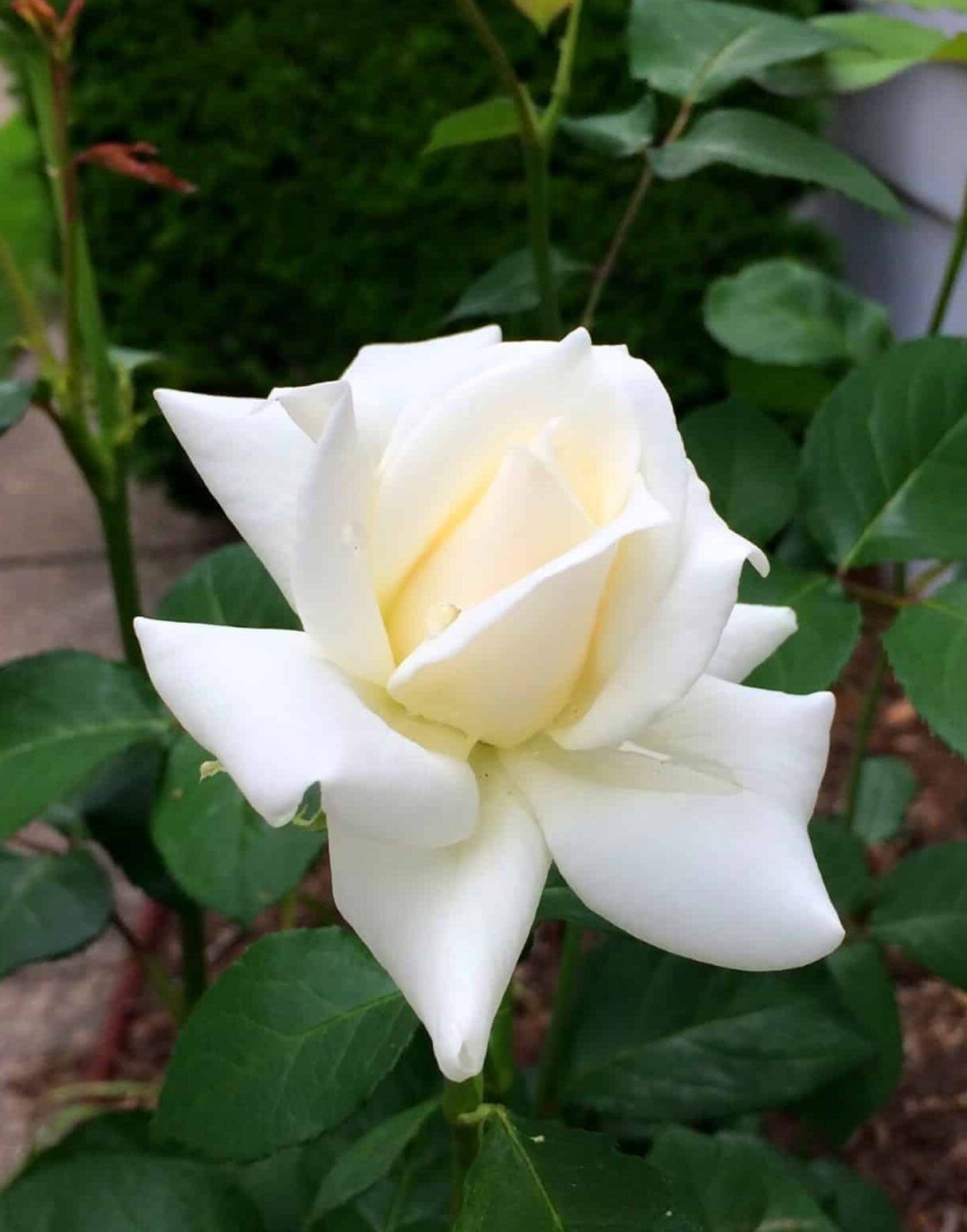Have you ever wondered why roses have thorns?
Thorns seem uncanny for such a beautiful flowering plant, but all pretty things need some sort of protection, don’t they?
Although crucial for roses, thorns or prickles can be a nuisance to gardeners. So, to know why roses have thorns and whether you could find rose species without one for your garden, stand by and read on!
Table of Contents Show
What is the Difference Between Thorns and Prickles?
Thorns in roses are ‘Prickles,’ which may look similar but differ based on origin and structure.
So, thorns are a harder growth on the plant, while prickles are comparatively softer and break easily.

However, they both perform the same function as a physical defense mechanism against small animals and as a grappling hook for holding on to nearby structures.
The sharp prickles on the stalk of roses grow almost 0.5-1 cm long and are hooked downwards.
However, unlike cactus spines or citrus thorns, rose prickles lack microscopic vessels that conduct sugar and water throughout the plant.
Some species of roses, such as Rosa ‘Zephirine Drouhin,’ are completely thornless and were first cultivated in 1868.
Moreover, the rose’s thorns symbolize misfortune or sacrifice.
Why do Roses Have Thorns?
According to the Ambrose of Milan, roses that grew in the Garden of Eden were completely thornless, and roses got these defenses when Adam and Eve disobeyed God!
Although it’s a farfetched theory and backed with many similar folklores, there are supportive scientific reasons for roses to have thorns or, more accurately, ‘prickles.’
1. For Clamping Onto Other Plants
Rose prickles primarily serve the vital purpose of clamping over other plants to rise further.
The sickle-shaped and pointy prickles enable rose bushes to hang upwards to surrounding vegetation to utilize the sunlight.
The sharp extensions clamp over other plants to rise and increase the surface area to get maximum sunshine for photosynthesis.
2. For Mechanical Defense
The predators of roses include small mammals, birds, and insects that come to devour the flower buds.
The downward-facing prickles provide exceptional protection against bugs who intend to suck the flower sap.
The prickles also protect against animals and birds often attracted by the strong fragrance of the flowers.

3. To Redirect Watering
These downward-facing prickles help to redirect water to the roots.
The prickles’ downward curve quickly redirects water from above to the root as water droplets.
So, they may indirectly help provide more water straight to the root system, especially during the dry season.
Do All Roses Have Thorns?
Thornless roses are often a result of a natural mutation that results in a hybrid plant.
Some rose varieties are entirely thornless, while others may acquire them late in life or under certain growing conditions.
Likewise, various varieties of roses are produced using different propagation methods, like using stem or flower cuttings.

As a result, hybridization is common in roses, but these hybrids may or may not sprout thorns.
So, thornless roses may not be entirely thornless. However, some thornless varieties are exceptionally popular.
1. Thornless Climbing Roses
Climbing roses result from the mutation of bush or hybrid tea roses. They are known for extra-long stems that continue to increase.
Some climbing rose species are thornless, growing up to 6-12 feet, producing large pink blooms with a heavy scent.
2. Thornless English Roses
English roses are hybrid rose species introduced in 1969 by the English rose hybridizer David Austin.
Also known as David Austin roses, these species combine the best elements of old and modern roses.

3. Thornless Heirloom Roses
Heirloom roses are a hybrid variety of old roses developed around 1867.
They grow taller than modern hybrids and become bushier each year.
These are easy-to-grow garden roses since bees pollinate them.
4. Thornless Hybrid Tea Roses
Hybrid tea roses resulted from cross-breeding between common tea roses and hybrid perpetual roses in 1867.
They grow from 3-7 feet tall to 3-5 feet wide, requiring USDA hardiness zone 5-9 to grow appropriately.

Top 10 Thornless Roses
Thornless roses have diverse seasonal requirements depending on the varieties.
So, verifying their hardiness is crucial before growing them.
Let’s see some buying recommendations for thornless roses from the table below.
| Rose Varieties | USDA Hardiness Zones |
|---|---|
| 'Irene Marie Miniature' Roses | 6a-9b |
| 'Amadis Thornless' Roses | 6b-9b |
| 'A Shropshire Lad' Roses | 4 and above |
| 'Bleu Magenta' Roses | 5-10 |
| 'Chloris' Roses | 3-9 |
| 'Cinderella Fairy Tale' Roses | 5 and above |
| 'Goldfinch' Roses | 6b-9b |
| 'Leander' Roses | 5b and above |
| 'Lykkefund' Roses | 5 and above |
| 'Reine des Violettes' Roses | 4-9 |
Roses for Sale
Many thornless and thorn-bearing rose varieties are ready to enter a florist’s home.
You can get some recommendations from the following table.
| Sites/ Name of Variety | Expected Delivery Date |
|---|---|
| Amazon | 4-5 days |
| Climbing Thornless Roses | 4-5 days |
| Hybrid Tea Rose (Spring Hill Nursery) | 5 days |
| Climbing Rose (Brecks) | Seasonal Shipping |
Frequently Asked Questions About Roses
Should you Remove Thorns from Roses?
Cutting the prickles will cause a wound on the rose stems, leading to moisture loss and dehydration.
Moreover, the holes on stems will also be the entryways for bacteria and germs.
Are Rose Thorns Poisonous?
Although rose thorns are not poisonous, they can scratch or prick the delicate skin of animals and birds.
They may also pass foreign elements like bacteria, fungi, and plant chemicals.
Do Rose Thorns Grow Back?
Rose thorns are extensions of the stem’s epidermis and do not originate from growing cells or tissues.
So they won’t grow back once you remove them.
Can you Grow a Rose from a Thorn?
Growing a rose from a thorn is impossible because thorns are an overgrowth of the skin layer of the stem.
Also, they lack the necessary special cells to differentiate into various plant organs.
From Editorial Team
Ensure Suitable Conditions to Grow Roses!
Whether roses are thornless or with thorns, all have a common set of growth requirements.
Offer them 4-6 hours of direct sunlight, weekly watering, temperature around 60-70°F, 60-70% humidity, fertilization every 2-3 weeks in spring and summer, and pruning and repotting in late winter to early spring.


